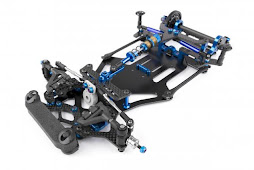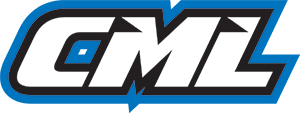Moving on to more build detail...
Decide your tyre diameter range
 |
| The new RC12R6 front end |
The minimum front tyre diameter I will will run down to is in the order of 39.6 mm. Starting the fronts at 40.8mm. This gives a tyre diameter range of 1.2mm .. which will be around 4-5 runs on 13.5 stock allowing for tyre wear. The ride height shim range will be half of the diameter range, around 0.6mm.
 |
| Steel shim kit and 0.5mm spacers will give the needed adjustment. |
To facilitate this you will need to be playing with the 0.5mm blue shim washers in the kit and I have purchased the optional metal shims (part 4742) which are 0.2mm each (you get 4 of them in the pack).
The design of the low blue stand off mounting the lower carbon wishbone to the chassis will allow for very small front tyre diameter... down to and beyond the rim if you like!
The reality is that you will be always using the 1mm spacer so why not mount that on top so it is secured in place always.
 |
| 1mm blue shim always on top of the standoff |
The standoff is not deep and takes thread from both sides. The lower side against the chassis will see the most action as continuous adjustments are made for ride height.
 |
| Size the top screw correctly. |
If you are not careful the screws will meet each other in the standoff before clamping down so watch out!
I ground 4 top screws to 8.25mm to allow enough thread free in the bottom when using a standard 5mm CSK to go up into the standoff from beneath the chassis. This length will allow the perminant location of the 1mm spacer as shown above.
Consistent front ride height.
I suggest giving this a good read as I will still do all of this building a car for the first time.
I have already written all the words over 12 years ago (see the link!) so here it in pictures for the RC12R6.
Hold your wishbone / stand off assemblies against each each other on a flat (very flat) surface and look to compare the ball height.
 |
| Height error seen |
Mine had an error of around 0.5mm (left is high). Not good. The standoffs+Shim arrangement was not true. It only takes a tiny angle error in the standoff - wishbone mount to make this a problem outboard.

I rotated the standoffs by 180 degrees (on the axis of the screw) on one side and tried it again. This was better. Fiddle with this till you get the best match.

Once mounted on the car. Block the chassis and check the axles are at the same static unloaded height.
Which Spring?

In the UK we run on various carpets but the "ETS" black rug is popular and setup notes below will assume the use of JFT S35 compound all round.
My preference backed up by testing the car at a couple of club meetings is to run the Associated .018 springs on the front end (Part 4144). The kit spring is the 0.020 which I think is a little too hard and immediate resulting in an aggressive immediate steering response followed by washing out a little.
Eliminate almost all front end Droop.
I would recommend taking nearly all of the droop out of the front end springs. I want the car to _just_ and only just sit into the front king pin springs. As recommended in the manual I run two 8425 shims (total 0.8mm) above the steering block.
I then shim above the top king pin ball, firstly to just take all the play out of the king pin so the spring is just touching. I then add a single 0.4mm shim in addition to slightly preload the spring such that static self-weight if the car only just parts the steering block from the lower ball when the car is sat on the pit table.
Finally I set appropriate ride height on a true set of wheels. I remove the rear springs and disconnect the rear dampers.
I then block under the front axles with 20mm Hudy blocks and check the ride height is the same left and right.
We really should be close to within 0.2mm. I may add or remove a 0.2mm shim to change the spring preload to make this right.
When you run the car for the first time the springs will compress and you will be chasing this for the first meeting. I use old springs!
Of course I don't use 5.1mm ride height! (see right). This is the effect of blocking the front axles at 20mm.
Finally (finally) I sit the chassis flat on the board and offer up a camber gauge to the steering block to make sure the left and right castor is the same. The RC12R6 block is moulded with a nice straight edge tab that helps with this.

Of course, during this process I have set the camber to 1 degree as a matter of course. many of these steps are iterative. You get the thing built rightly and then progress the accuracy until dead right.
Finally... finally finally.... I did cheat a bit and ended up using a Xenon top ball carrier with a Roche ball in it. I fell out of love with the verticle movement of the Associated one. To be honest I am being way too picky here and would not have bothered if I did not have the bits.

























































